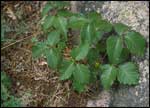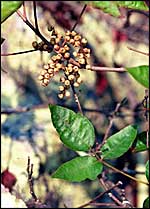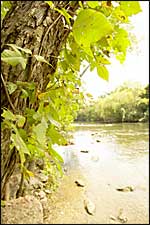Poison Ivy
“Leaflets three, let it be!” “Leaflets three, quickly flee!” These may be only children’s rhymes, but they are ones which young naturalists and all outdoorsmen should heed to avoid the torments of poison ivy. Each year countless people fall victim to the irritations of this dreaded plant. In many instances contact could have been avoided if the individuals had been able to identify this plant on sight.

As the rhymes indicate,
poison ivy grows with
three leaflets on each
leaf stalk, and this is
the only dependable characteristic
of the plant. The leaves
can vary in size, shape,
color and luster. They
can be dull or glossy,
broad or thin and have
smooth or jagged edges.
Crinkly, young leaves
are red or purplish when
they unfold in the spring.
Summer finds the mature
leaves in varying shades
of green, and autumn turns
them beautiful shades
of yellow, red, and orange.
Poison ivy grows as a shrub or vine. Shrubs may vary from a few inches to several feet in height. Vines trail along the ground to form a dense covering or climb any object in their path. Fences, stone walls, buildings, trees, or telephone poles often are covered with the spreading growth, which is capable of climbing fifty to seventy-five feet above the ground. Kinky, brown aerial rootlets cover the vines and attach themselves to crevices or small openings in the object being climbed. These rootlets cause the vine to look like a fuzzy rope and will help identify the plant. In early summer, clusters of small, five-petaled, yellowish green flowers appear on the ivy. These flowers are followed by small green berries that ripen to a white or ivory color. The outer skin of the berry is lined and resembles the segments of a peeled orange.

All parts of the poison ivy plant contain the oily substance, urushiol, which causes the skin irritations. Its green berries ripen to a white or ivory color.
The toxic ingredient in poison ivy is an oily substances called urushiol, which occurs in the sap and is present in all parts of the plant—leaves, flowers, fruits, bark, stem, and roots. The substance is potent at all times of the year and even when the plant is dead. Leaves stored for five years at room temperatures were almost as toxic as when fresh. Branches of ivy that were cut and left outdoors on a garage roof for eighteen months were still found to be dangerous.
Identifying poison ivy and staying away from it will help most people avoid contamination, but you can be infected through indirect methods. Urushiol can be transferred to the skin when you are removing your shoes or touching tools or camping equipment that have come into contact with the plant. Since the oily substance sticks to animal fur, petting the family dog after it has had a run in the woods also can transfer the infection.

Smoke from burning poison ivy will cause indirect contamination. Penetration of light clothing by the oil droplets trapped in the smoke will cause irritation of unexposed parts of the body. Many unsuspecting people have cut down or cleared out their poison ivy vines, being careful at all times not to come into contact with them, only to be covered with the irritating oil when burning the plants to get rid of them. A few camping trips also have been ruined when parts of the plant have somehow gotten mixed in with the firewood or when the camper was foolish enough to build his fire on some of the vines on the ground.
If, regardless of caution, you somehow are exposed to poison ivy, thorough scrubbing with a heavy duty soap several times during the first half-hour after contact may avert poisoning or at least lessen the effects. Clothing worn in the woods should be thoroughly washed before it is worn again.
Sensitivity to the poison varies with the individual. One person may have only a few itchy bumps or blisters while another becomes a hospital case with the inflammation spreading to the internal organs. Lotions, such as calamine, may help ease the itching, but extreme cases should be treated by a doctor since shots or other medication may be necessary.
Remember the rhymes and avoid this three-leaved menace whenever you’re picnicking, camping, hiking, fishing, riding, hunting, or strolling through the woods. Being careless can cause many days of pain and itching.
Ilo
Hiller
1983 Poison Ivy. Young
Naturalist. The Louise
Lindsey Merrick Texas Environment
Series, No. 6, pp. 102-103.
Texas A&M University
Press, College Station.